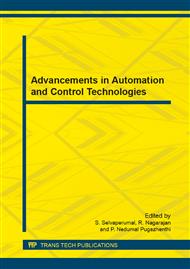[1]
T. Charles Clancy, A. Khawar and Timothy R. Newman, Robust Signal Classification Using Unsupervised Learning, IEEE Transactions on wiresless communications., vol. 10, No. 4, pp.1289-1299, April (2011).
DOI: 10.1109/twc.2011.030311.101137
Google Scholar
[2]
T. Charles Clancy, Timothy R. Newman, Robust Signal classification using unsupervised learning, April (2009).
Google Scholar
[3]
T. Newman and T. Clancy, Security threats to cognitive radio signal classifiers, , in Vitgina Tech Wireless Personal Commun Symp., June (2009).
Google Scholar
[4]
A. Khawar and T. Clancy, Signal classifier using self-organising maps: performance and robustness, in SDR Forum Technical Conf., Dec (2009).
Google Scholar
[5]
T. Clancy and A. Khawar, Security threats to cognitive radio radio signal classifiers, in International Conf. Cognitive Radio Oriented wireless Netw. Commun., June (2009).
DOI: 10.1109/crowncom.2009.5189050
Google Scholar
[6]
A. Fehske, J. Gaeddert and J. Reed, A new approach to signal classification using signal correlation and neural networks, in New Frontiers Dynamic Spectrum access Netw., Nov (2005).
DOI: 10.1109/dyspan.2005.1542629
Google Scholar
[7]
T. Yucek and H. Arslan. A survey of spectrum sensing algorithms for cognitive radio applications, IEEE Commun Surveys Tutorials, vol. 11 Mar (2009).
DOI: 10.1109/surv.2009.090109
Google Scholar
[8]
R. Chen, J. Park and J. Reed, Defence against primary user emulation attacks in cognitive radio networks, IEEE J. Sel. Areas Commun, vol 26, pp.25-37, Jan (2008).
DOI: 10.1109/jsac.2008.080104
Google Scholar
[9]
S. Kay and J. Marple Spectrum analysis-a modem perspective, proc. IEEE, vol. 69, pp.1380-1419, Nov. (1981).
DOI: 10.1109/proc.1981.12184
Google Scholar
[10]
W.A. Gardner, Stasistical Spectal Analysis: A Nonprobabilistic Theory. Prentice Hall. (1988).
Google Scholar
[11]
W.A. Gardner, Introduction to Random Process with Applications to Signals and System. Macmillan. (1996).
Google Scholar
[12]
P. Sutton. K Nolan and L. Dovle. Cyclostationary signatures for rendezyous in OFDM-based dynamic spectrum access networks. , 2nd IEEE International Symp, New Frontiers Dynamic Spectrum Access New. Pp. 220-231, Apr. (2007).
DOI: 10.1109/dyspan.2007.37
Google Scholar
[13]
J. Hartigan and M. Wong, A K-means clustering algorithm, Applied Stastistics, vol. 28 pp.100-108, (1979).
Google Scholar
[14]
T. Kohonen. The self-organizing map, , Neurocomputing, vol. 21, pp.1-6 Nov-(1998).
Google Scholar
[15]
T. Clancy and N. Geoergen, Security in congnitive radio networks: threats and mitigation, , in International Conf. Cognitive Radio Oriented Wireless Netw. Commun. May (2008).
DOI: 10.1109/crowncom.2008.4562534
Google Scholar
[16]
D. Pelleg and A. Moore, X-means: extending k-means with efficient estimation of the number of clusters, , in International Conf. Machine Learning. June (2000).
Google Scholar
[17]
J. Mitola, Cognitive radio: an integrated agent architecture for software defined radio, Ph. D dissertation, KTH (2000).
Google Scholar
[18]
FCC, FCC adopts rules for unlicensed use of television white spaces,. Available: http: /hraunfoss. fcc. gov/edocs_public/attachmatch/FCC-04-113A1. pdf.
Google Scholar


